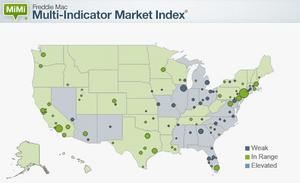MCLEAN, VA--(Marketwired - Dec 30, 2015) - Freddie Mac (
The national MiMi value stands at 81.9, indicating a housing market that is on its outer range of stable housing activity, while showing an improvement of +0.59 percent from September to October and a three-month improvement of +1.54 percent. On a year-over-year basis, the national MiMi value has improved +6.31 percent. Since its all-time low in October 2010, the national MiMi has rebounded 38 percent, but remains significantly off from its high of 121.7.
News Facts:
- Thirty-two of the 50 states plus the District of Columbia have MiMi values in a stable range, with the District of Columbia (101.1), North Dakota (95.3), Montana (95.1), Hawaii (94.1) and Utah (92) ranking in the top five. Compared to the same time last year, 21 states and the District of Columbia had MiMi values in a stable range.
- Fifty-three of the 100 metro areas have MiMi values in a stable range, with Fresno, CA (101.9), Austin, TX (96.5), Honolulu, HI (95.5), Salt Lake City, UT (95.2) and Los Angeles, CA (95) ranking in the top five. Compared to the same time last year, 29 of the top 100 metros had MiMi values in a stable range.
- The most improving states month-over-month were New York (+1.90%), New Jersey (+1.79%), Florida (+1.29%), Nevada (+1.27%), and Oregon (+1.26%). On a year-over-year basis, the most improving states were Florida (+14.47%), Oregon (+12.2%), Colorado (+11.97%), Washington (+11.69 %) and Nevada (+11.13%).
- The most improving metro areas month-over-month were Allentown, PA (+1.99%). Tampa, FL (+1.98%), Cleveland, OH (+1.93%), Palm Bay, FL (+1.91) and Las Vegas, NV (+1.69%). On a year-over-year basis, the most improving metro areas were Orlando, FL (+17.94%), Tampa, FL (+16.94%), Cape Coral, FL (+16.60%), Denver, CO (+15.21%) and Palm Bay, FL (+14.78).
- In October, 43 of the 50 states and 89 of the top 100 metros were showing an improving three-month trend. The same time last year, 36 of the 50 states, and 70 of the top 100 metro areas were showing an improving three-month trend.
Quote attributable to Freddie Mac Deputy Chief Economist Len Kiefer:
"The strong annual change of 6.31 percent is the best improvement we've seen in the MiMi on a year-over-year basis since July 2014. While strong home purchase applications and rising home values in some markets are contributing to this improvement, its largely more of a reflection of mortgage delinquencies continuing to decline at a steady pace, especially in those hardest hit markets, and a better employment picture overall. States in the West are still seeing some of the strongest housing activity and among those Utah really stands out. Not only do many of the state's local housing markets such as Salt Lake City, Provo and Ogden have strong buyer demand but they're also still largely affordable for the typical family looking for a median priced home. This is due to the state's robust economy and better than average job creation."
"We do expect homebuyer affordability to decrease in the coming year, but we don't expect tighter monetary policy to generate a spike in longer-term interest rates in the foreseeable future. The Fed has committed publicly to measured increases in short-term rates. While mortgage rates will rise modestly, they will still remain at historically low levels. Combined with stronger job and income growth, the net result may be strong growth in household formation, construction, and home sales."
The 2016 MiMi release calendar is available online.
MiMi monitors and measures the stability of the nation's housing market, as well as the housing markets of all 50 states, the District of Columbia, and the top 100 metro markets. MiMi combines proprietary Freddie Mac data with current local market data to assess where each single-family housing market is relative to its own long-term stable range by looking at home purchase applications, payment-to-income ratios (changes in home purchasing power based on house prices, mortgage rates and household income), proportion of on-time mortgage payments in each market, and the local employment picture. The four indicators are combined to create a composite MiMi value for each market. Monthly, MiMi uses this data to show, at a glance, where each market stands relative to its own stable range of housing activity. MiMi also indicates how each market is trending, whether it is moving closer to, or further away from, its stable range. A market can fall outside its stable range by being too weak to generate enough demand for a well-balanced housing market or by overheating to an unsustainable level of activity.
For more detail on MiMi see the FAQs. The most current version can be found at FreddieMac.com/mimi.
Freddie Mac was established by Congress in 1970 to provide liquidity, stability and affordability to the nation's residential mortgage markets. Freddie Mac supports communities across the nation by providing mortgage capital to lenders. Today Freddie Mac is making home possible for approximately one in four home borrowers and is one of the largest sources of financing for multifamily housing. Additional information is available at FreddieMac.com, Twitter @FreddieMac and Freddie Mac's blog FreddieMac.com/blog.
